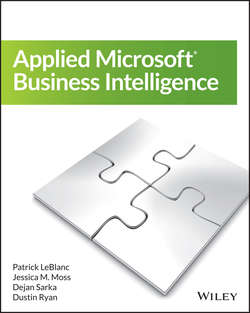Читать книгу Applied Microsoft Business Intelligence - Sarka Dejan - Страница 15
На сайте Литреса книга снята с продажи.
Part I
Overview of the Microsoft Business Intelligence Toolset
Chapter 2
Designing an Effective Business Intelligence Architecture
Implementing and Enforcing Data Governance
ОглавлениеThe section “What Are the Data Sources,” reiterated the importance of a group of end users over and over again. You have a similar case when deciding how to implement and enforce data governance. From a technical perspective, this step is typically performed prior to loading the data in the data warehouse. So, why is it located after the data warehouse section? When planning a business intelligence solution, time is valuable. Why invest time and resources on something that you may not need? If data is accessed directly from the source, the want or need for data governance is reduced. However, because you may have multiple sources of data for a single data warehouse, you may require a data governance strategy to ensure that you deliver accurate, consistent, and trustworthy data to end users. Figure 2.3 illustrates where data governance would fit in a Microsoft business intelligence solution.
DATA GOVERNANCE
So, what is data governance? In short, data governance is a process or set of processes that include:
● Data quality
● Data management
● Data monitoring
● Data maintenance
● Data security
Figure 2.3 Data governance in a business intelligence project
These tasks are accomplished by putting people familiar with the data together with a technology solution or set of solutions. In the case of Microsoft, it would be a set of technologies: Data Quality Services (DQS) and Master Data Services (MDS).
NOTE
A discussion about these technologies is well beyond the scope of this book; however, the exclusion of a data quality process could be detrimental to the entire business intelligence solution. The Tutorial: Enterprise Information Management using SSIS, MDS and DQS Together, teaches developers how to implement a sample Enterprise Information Management (EIM) solution. It can be downloaded from this link: http://www.microsoft.com/en-us/download/details.aspx?id=35462.
For example, assume that during the data discovery process you realize that two very similar datasets are obtained from two completely different sources; for the sake of brevity and simplicity, assume that both datasets reference gender data. The catch is that in one system gender is stored as Male and Female, and in the other the data is stored as M and F. Prior to importing the data into the data warehouse, a decision must be made regarding how to store gender; this is part of the data governance process. Using the knowledge of those individual stakeholders and the technology of choice (MDS and DQS in this case) you can implement a process that ensures that the data is accurate and consistent.
